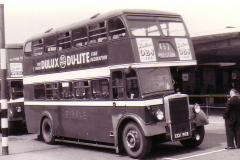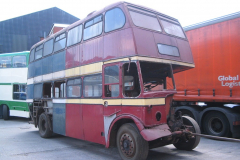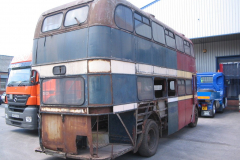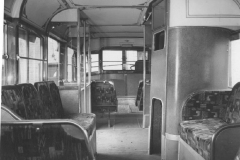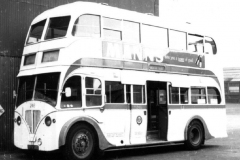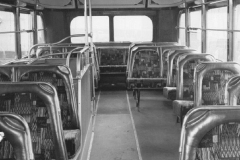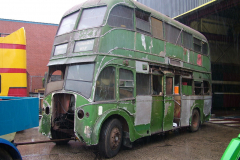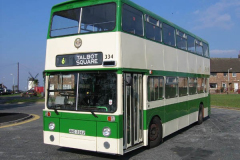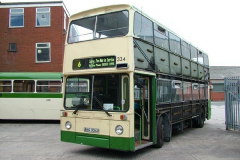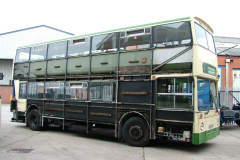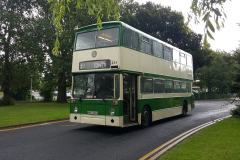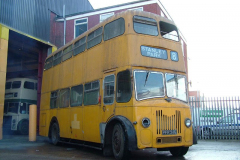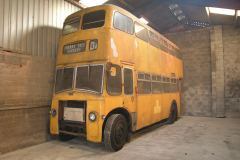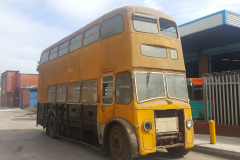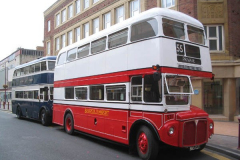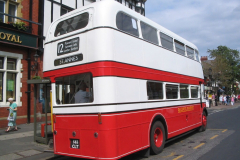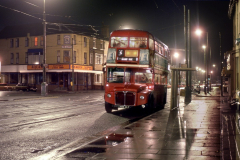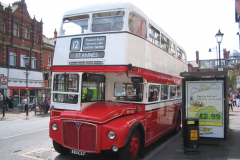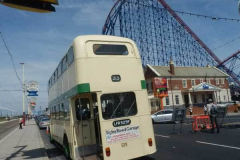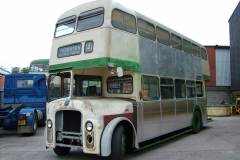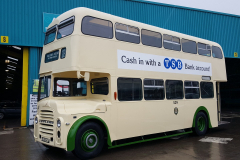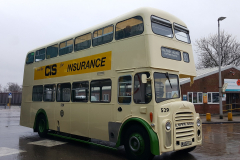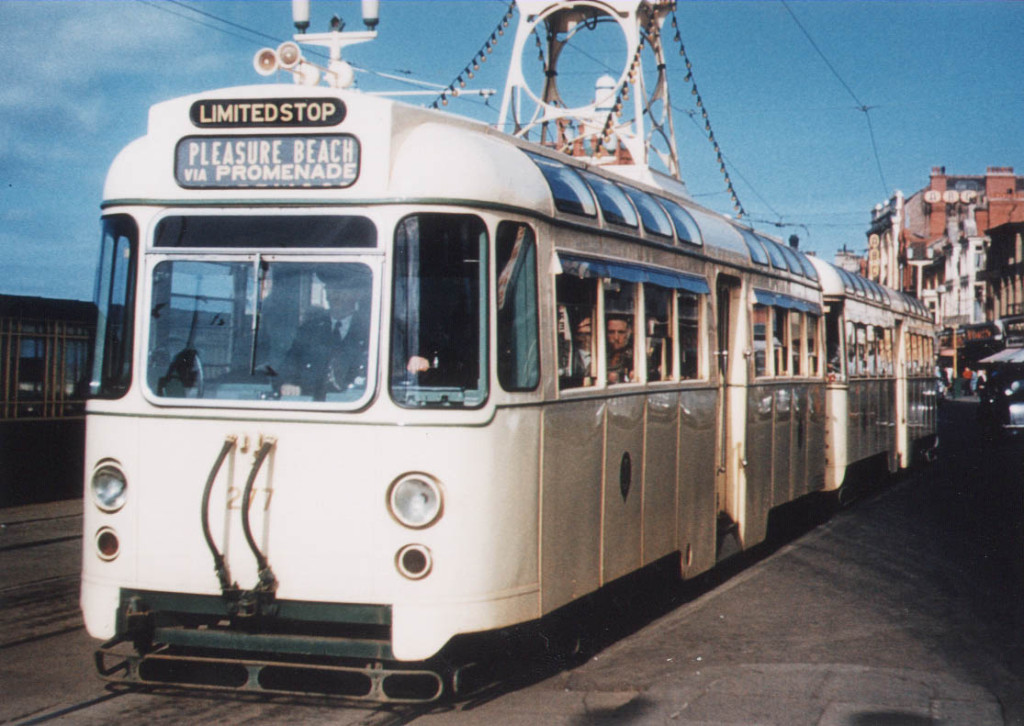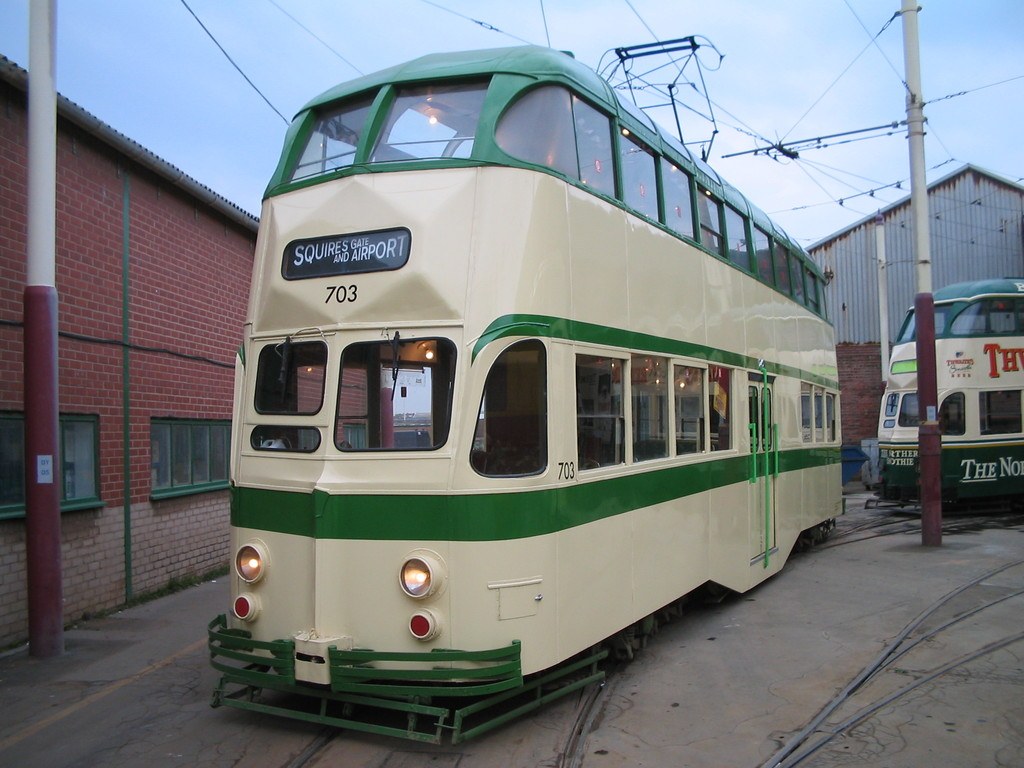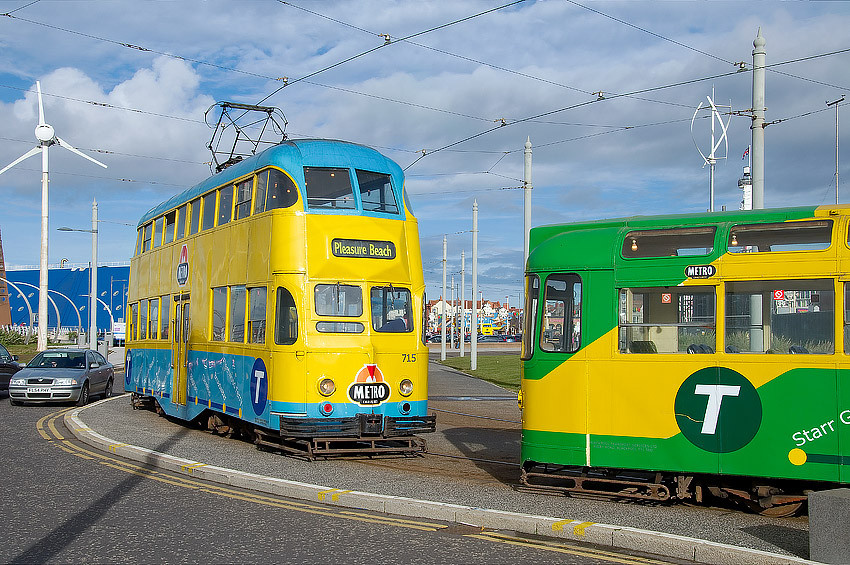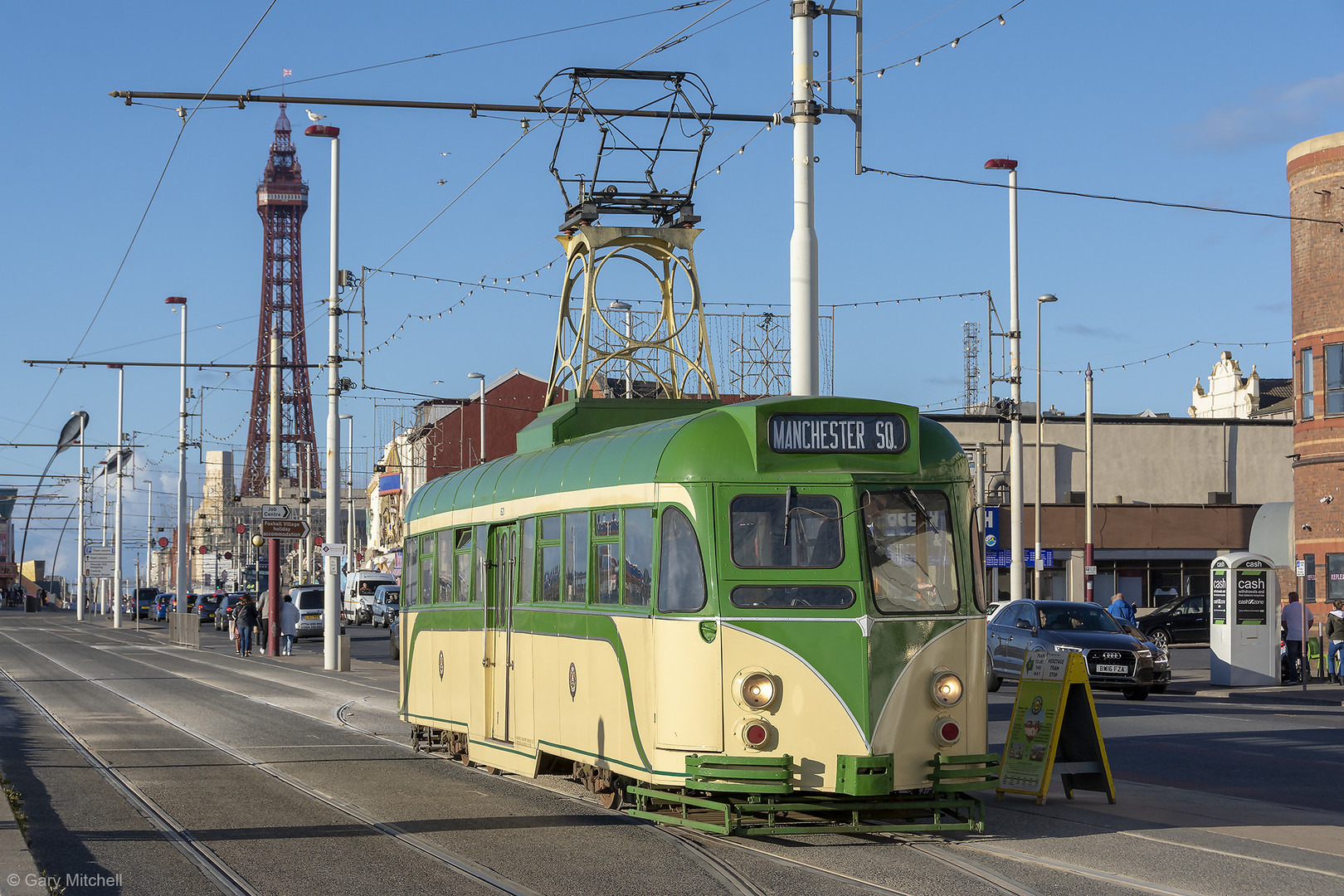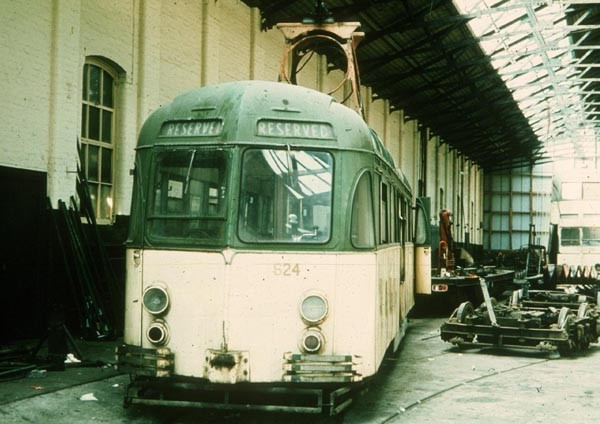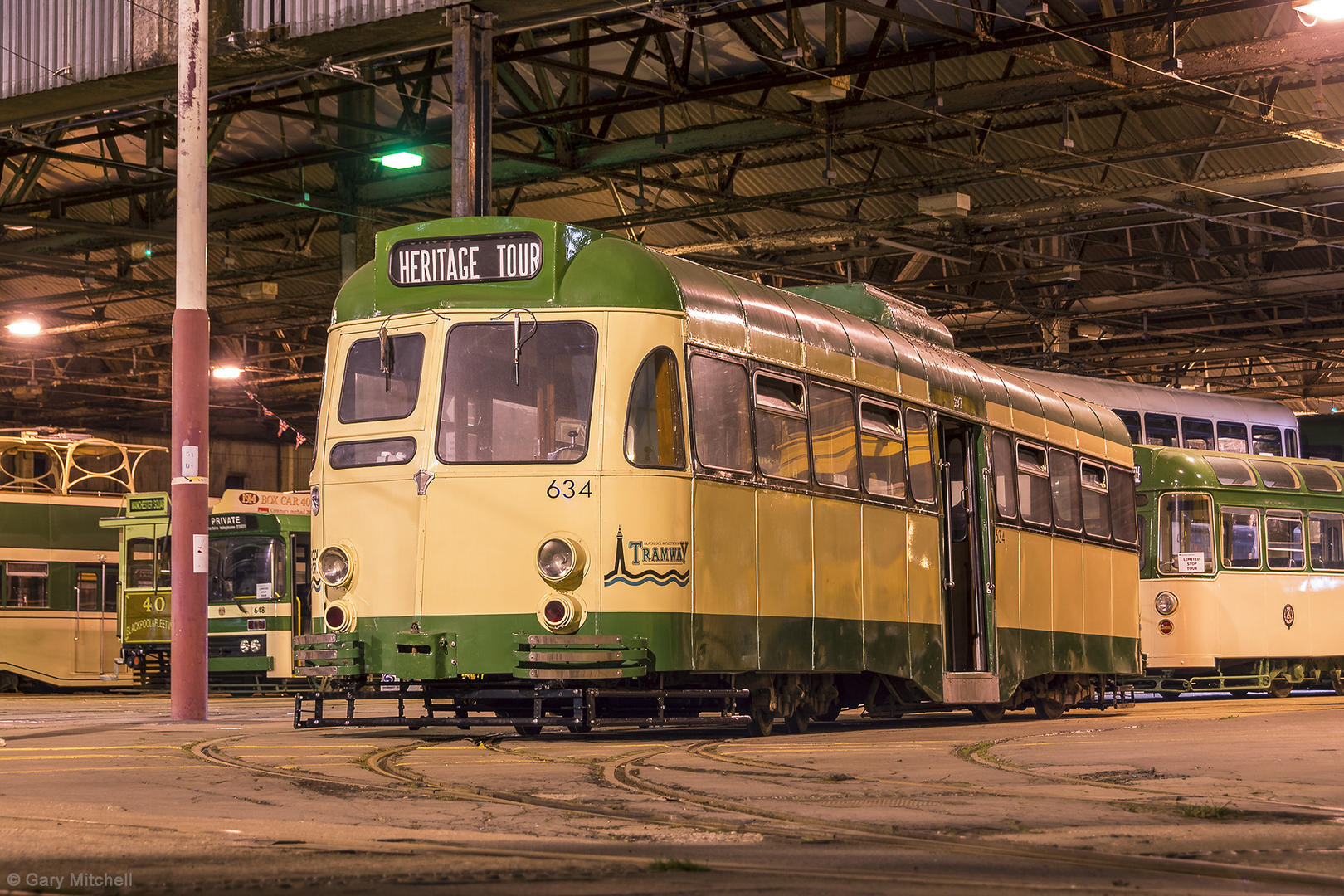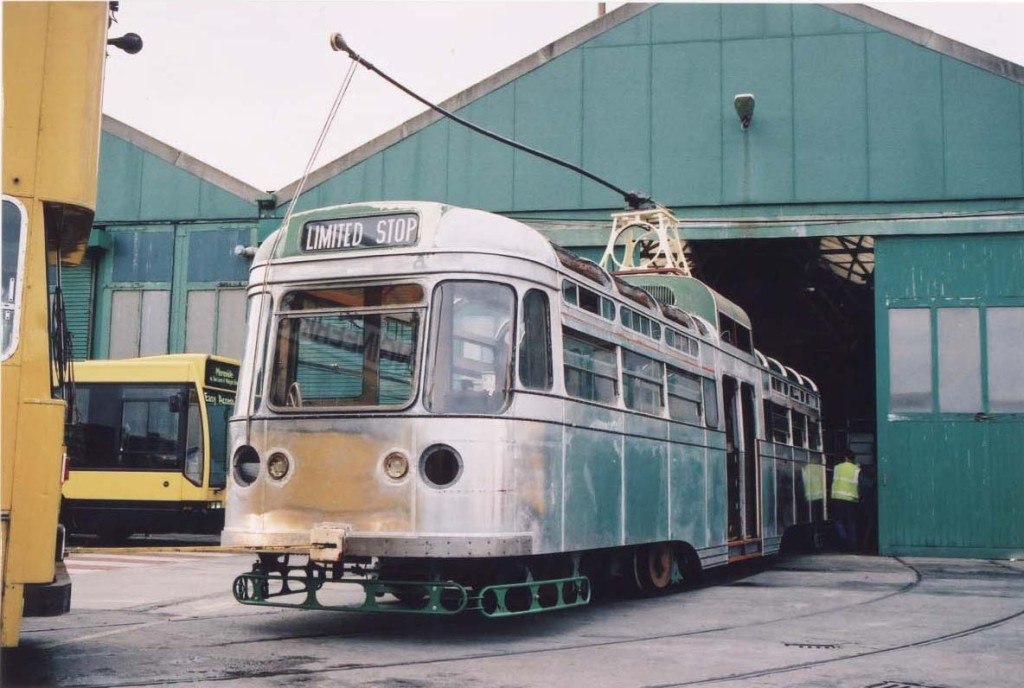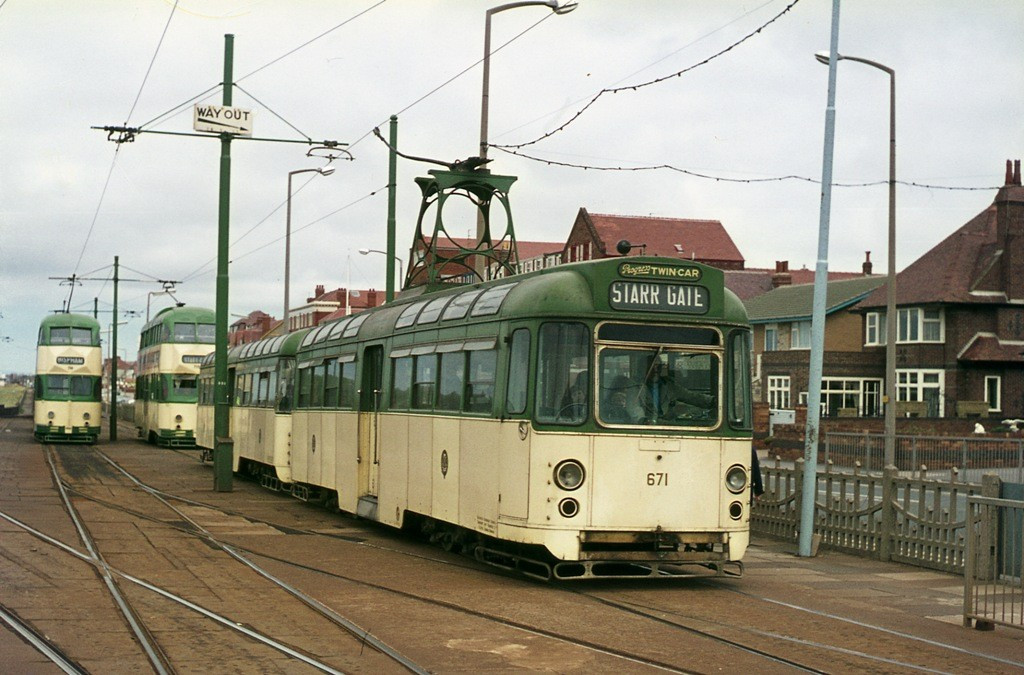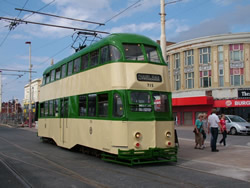
We have a number of Blackpool trams as part of our preserved collection, spanning the history of the resort’s famous seaside tramway and you can see their details and photos below.
Our tram collection is housed at Rigby Road depot courtesy of Blackpool Transport Services. As each tram is restored it is placed on loan to BTS so that they can use it as part of their Heritage Trams Tours. Details of the tours and more about the tramway can be found at blackpoolheritage.com
Standard 143
Blackpool Corporation built a fleet of 42 ‘Standard’ cars during the 1920s in response to both growing patronage on the tram routes and a need to rationalise the assortment of tram types, many originating from the early 1900s.
No.143 was built by the Corporation in 1924 as an unvestibuled, open balcony ‘Standard’. Later, in December 1929 the tram received enclosed drivers vestibules and upper deck. The red and cream livery was replaced by green in June 1934.
Withdrawal of the Standards began in the 1940s and the numbers thinned out during the 1950s as the Coronation class arrived. However, a handful survived in service as late as 1966 and a number of them survive in preservation.
This car has a rather unique history. Withdrawn from passenger duties in October 1957, it was fitted with a bus engine and generator set to allow it to operate separate from the overhead. An inspection tower was fitted on the upper deck and the tram transferred to Engineering car duties. Later renumbered 753 in the works car fleet, it survived on such duties until June 1990 when the engine caught fire and gutted the lower deck saloon. Retained by Blackpool Transport for possible restoration as a Standard car, a project to acquire sister car No.147 from an American museum led to 753 being cannibalised and withdrawn surplus to requirements.
Unwilling to see such an historic tram broken up, the car was donated to the LTT in February 2002 and was transferred to our Clifton Road depot on 13 April 2003 to await future restoration.
A grant application was submitted to the Local Heritage Initiative in August 2005 for a project to fully restore the tram to original 1924 condition, as an open platform, open vestibule tram, a type not represented by any of the other preserved Blackpool Standards. Work on the project started in November 2005 and 143 returned back to Rigby Road depot in August 2010 for completion by Blackpool Transport.
Unfortunately, the pressure of work to upgrade the tramway and the retained double deck cars resulted in no work being undertaken on 143 and the realisation that the extent of heritage operation would be minimal led to BTS not being in a position to honour their pledged partnership agreement dating back to 2005. As a result, car 143 was stored until November 2018 when a revised agreement was negotiated with Blackpool Transport.
During the remainder of 2018 and throughout 2019, the work on 143 was completed in a joint project involving Blackpool Transport staff, contractors and volunteers and the car was launched, looking superb, on 23rd September 2019.
Railcoach 279
During the 1930s Blackpool Corporation spent thousands updating the tram fleet with over a hundred streamlined centre entrance tramcars. This investment helped the tramway survive to the present day. Walter Luff, the General Manager of the transport department from 1933, led the revolution of Blackpool’s tramway and many of the trams introduced during the 1930s are still in service at Blackpool today
The first design to be introduced was the Railcoach, a streamlined centre entrance single deck design that included features from contemporary coach design which competed with the tramway for tourist traffic. 45 Railcoaches were built at the Preston workshops of English Electric whilst other designs included an Open top single decker, and both enclosed and open-top double deck designs of similar streamlined appearance.
45 Railcoaches were delivered in two batches, 25 in 1933/4 (Nos.200-224) and 20 more in 1935 (264-283). Our example, No.279, formed part of the second batch and was largely confined to the main Starr Gate to Fleetwood service, though in later years the Railcoaches were used on the Marton, Squires Gate and North Station routes which were closed in the early 1960s.
In 1958 an experiment with trailer operation resulted in ten Railcoaches being rebuilt with Coronation-car style end profiles to tow new 66-seat trailers. All were painted in all-cream livery initially and were used during the summer months as a means of increasing the number of high capacity trams.
Later seven of the trailers were permanently coupled to their towing cars but three (including 279 - now renumbered 679) were never converted and from 1972 they operated without their trailers.
22 Railcoaches were scrapped in the 1960s (or converted for other uses), 10 had become trailer towing cars and the remaining 13 were converted into one man trams in the 1970s, resulting in the original Railcoach design disappearing from the tramway.
678-680 were fitted with heaters for winter use and have outlived their trailers which were scrapped. From the late 1980s, advertising liveries began appearing on the trio and in early 1990s, 679 was overhauled with rebuilt underframe and, later still, bus seating and flush mounted glazing.
In 2004, 679 reverted to its 1980s style green and cream livery. However, despite this, the tram operated infrequently in 2004 and as part of a general reduction in the size of the operational tram fleet, 679 was withdrawn at the end of the year. In November 2008 it was acquired by the LTT for preservation.
679 is being rebuilt to its original cab-end design as a streamlined Railcoach. This complex job has involved the fabrication of new cab underframes and steel cab end framework to the style of the original wooden cab framings. Swing over seats have been refitted; new half drop windows made and installed and the interior wood work stained. Task required to complete the car include modification to the wiring to suit the new cab layout; installation of new windscreens and fabrication of new domes.
After a pause in the work following the failed attempt to complete the tram in 2010, restoration work restarted in September 2018 and is progressing well, with a view to completion in 2020.
Balloon Car 703
Twelve streamlined open top double deckers were supplied by the English Electric Company of Preston in 1934. Officially called “Luxury Dreadnoughts”, after the old Dreadnoughts they replaced, they were numbered 238 – 249 and followed a prototype (226, later 237) which had been delivered for evaluation earlier that year. 703 was the third of the production order and was originally numbered 240. The open top cars, including prototype 237, were put to work on a new Promenade service to Cleveleys. They were designed to work all year round as the spartan open top decks, with wooden seating, could be closed off leaving the luxurious “Railcoach” style lower saloon available for use. Had war not intervened, it is possible that they may have remained in their open top condition but a requirement for a greater number of high capacity year round cars saw all thirteen Luxury Dreadnoughts enclosed during 1941/2, making them outwardly similar to the fourteen Balloons delivered in 1934/5 (which includes our 715).
The newly enclosed cars lacked the sliding sunshine roofs of the Balloons, and much of the comfort as the upper deck wooden seating was not replaced with cushioned Railcoach style seating, but merely thinly covered with matching moquette. Nevertheless, the expanded fleet of 27 Balloons were used year-round on Promenade to Cleveleys, and Lytham Road services, but would not venture further north to Fleetwood until later in their career.
Repainted into a mainly green livery during the war, and then rather neglected for some years afterwards, the Balloons fell out of favour as manager Walter Luff favoured high frequency single deck cars on service. In 1952, the first of 25 single deck Coronations arrived, and the Balloons were relegated to summer season use only – although Blackpool’s was a long summer season from Easter until the end of the illuminations in November. From 1954 the Balloons began to be upgraded as the new manager Joe Franklin recognised their potential as crowd shifters during the season. A brighter livery was introduced, whilst other changes (introduced gradually) included adding additional seating upstairs and replacing the twin destination screens with larger single screens, which our “240” received in 1956. All 27 Balloons survived the contraction of the tramway in the early 1960’s, and in 1968 were renumbered 700 – 726.
703 was overhauled in 1970 and was fitted with cushioned seating upstairs (from scrapped Railcoaches). Much use was made of Darvic plastic interior panelling, to replace the original Alhambrinal, but 703 did retain curved upper deck side roof windows, now rubber mounted.
703 remained in green and cream, in various styles, throughout its working life in Blackpool despite the application of all over advertising liveries to many Balloons in the years from 1975. However, it was the recipient of two heritage liveries; the first (in 1995) saw 703 return to the mainly green wartime style, to commemorate 50 years since the end of the war. Then, in 1998, it received the 1980’s style which was ironic as 703 had been one of three Balloons to not actually received this style during that period. This was reapplied in 2004.
703 was withdrawn in 2008 as part of the rundown of the traditional fleet in advance of the tramway upgrade. It was acquired by the trust and sent on loan to the Beamish Museum in Durham following a repaint in a representation of Sunderland Corporation livery (Sunderland had some similar trams) and a final outing in Blackpool for the benefit of photographers. With the fictitious identity “Sunderland 101”, 703 ran at Beamish from 2011 to 2015 and was a useful people mover at this busy museum. It was latterly acquired by Beamish but withdrawn from use in 2015 with a defect. In 2016 Beamish offered 703 to the Blackpool Heritage Trust (BHT), and following an appeal for transport funding, it arrived home in March 2017. Having come full circle, 703 re-joined the FTT collection in December 2019 following the merger of the two trusts. The tram is not currently serviceable and requires repairs to the defect that saw it side-lined from use at Beamish.
Balloon Car 715
715 was one of the second batch of English Electric double deckers ordered by Walter Luff - this time fully enclosed cars instead of the open toppers delivered first. As with most trams of the Luff era, they were well appointed, ornate, streamlined, centre entrance cars. Sliding sunshine roofs were provided for warm summer days. Our car was new as No.252 in January 1935 and operated from the Rigby Road depot on the Promenade and Lytham Road routes. Initially painted green with cream skirt, cream band on upper deck panels and cream upper deck window surrounds, the car gained the mainly green wartime livery in the early 1940s.
Various modifications took place after Luff retired with new manager Joseph Franklin progressively stripping the cars of their decorative add-ons. The most significant was the replacement of the twin destination indicators with a larger, clearer, single unit and 252 was one of the first so treated in 1956. A rare escape from Rigby Road took the car to Marton depot for a brief period in 1962 - Balloons providing certain workings on this normally single deck service at school times. 252 became 715 in the 1968 renumbering.
It was not until the 1970s that further modifications befell 715. It was one of the last to retain its sliding roof losing this and its roof windows during winter 1976/7. Early summer 1981 saw a further overhaul with the car extensively repanelled, losing the 'between decks' panel split and emerging largely in the condition it is today.
1980s livery was applied in May 1986, and a pantograph was fitted in November 1990. The 1990s livery (see picture above) was applied for the first time in October 1992.
For the 2005 season 715 received its only all-over advert for the Pleasure Beach mystique show, though the vinyls were removed for the 2006 season with the car running in plain white until April 2008 when it gained the Line 16 light blue and yellow Metro style scheme.
The car was secured for preservation in January 2010 and in a radical move the LTT invited Blackpool residents and tram enthusiasts to become shareholders in a project to return 715 to green & cream livery in the condition it emerged back in 1981. During the illuminations of 2010, preserved 715 operated in its "Line 16" livery but in May 2011 it finally entered the paint shop. 715 returned to use on 4 June after its green and cream repaint and was used regularly throughout the 2011 summer season until the last day of traditional tramway operation on 6th November 2011.
715 rejoined the operating heritage fleet May 2015, painted in 1990s fleet livery. A partial repaint was applied in 2019 back to 1970s livery with period adverts for Blackpool Zoo and CIS insurance. 715 has been an active member of the heritage fleet.
Brush Railcoach 621
Tram 621, originally 284, was the first of 20 streamlined Railcoaches (284-303) supplied by the Brush Electrical Engineering Company of Loughborough in 1937. The Brush Railcoaches were extremely luxurious vehicles for their time, featuring deep cushioned seats, concealed saloon lighting, decorative Alhambrinal panelling and clocks in both saloons. Sliding sunshine roof panels and full wind down saloon windows provided plenty of fresh air on fine days.
The 20 Brush Railcoaches were set to work on Fleetwood, Promenade and Lytham Road services, with 284 entering service in July 1937. In 1940 the class was transferred to Bispham depot to work North Station to Fleetwood, and Lytham Road services, and as the war progressed their original cream and green livery was replaced by a mainly green style but with attractive cream sweeps on the side panels and a distinctive cream “V” on each end. After the war, brighter livery styles began to return, but the Brush Railcoaches remained at Bispham depot until this closed, along with the North Station route, in 1963. At this time 19 of the type transferred back to Rigby Road depot to operate the remaining Starr Gate to Fleetwood service, whilst the last member of the class, 303, was scrapped as non-standard having previously been used as a test bed for a new control system.
The class was renumbered 621-638 in 1968, and during the 1970s thirteen Brush cars were overhauled to a simplified specification which removed much of the former elegance from the saloons, replacing this with plastic ceiling panels, Formica above the windows and exposed bulb saloon lighting. The original full drop windows were replaced by half drop units from scrapped English Electric Railcoaches, which also donated their Z type controllers to replace the Crompton Parkinson units originally fitted, but which were now non-standard with the retained tramcar fleet. Conversions from the original twin destination screens to large single screens had started with car 288 in 1957, but our 621 was the last in service to retain twin screens, not being converted until 1980. For the 1985 season 621 received the first of many all over advertising liveries, in this case for Pleasure Beach attractions.
In 1987, 621 was treated to a comprehensive overhaul which included underframe repairs and a full rewire. New saloon glazing with hopper openers were installed, but apart from this, 621 remained traditional in appearance, and managed to escape some of the more extreme modifications made to fellow class members over subsequent years. Following overhaul, the tram was returned to use in green and cream fleet livery once more, this being updated in 1994 to the brand-new style featuring a green roof, centre doors and skirt, but with the rest cream. However, by 1996 621 was back in all over advertising, and would remain so, with periodic livery changes, for the remainder of its service career.
At the end of 2004 621 was withdrawn from service as one of 25 trams “mothballed” due to decreasing passenger numbers and to cut down the need to maintain such a large fleet. Initially 621 remained mobile, and could be seen shunting around the depot, but latterly it became stored in a gradually deteriorating condition.
In 2011, 621 was sold to the Fleetwood Heritage Leisure Trust and moved to Kirkham prison for storage and restoration work alongside classmate 627. However, 621 was subsequently acquired by a private consortium in 2014 and donated to the Beamish Museum near Durham, for eventual restoration. In a twist of fate, and following two years stored in the North East, Beamish offered the unrestored tram back to Blackpool in 2016, with the tram arriving back home at Rigby Road in the care of the Blackpool Heritage Trust (BHT) on 8th December. Transport costs to return the tram to Blackpool were covered by Peter Watts of PW Consultancy.
The 80th anniversary of the class in 2017 provided the impetus to restore 621 to service in Blackpool and with sponsorship received from Trams Magazine/The Blackpool Tram Shop, 621 was overhauled and restored to service in September 2017. It remains in its 1987 overhaul specification but is today beautifully painted in the ornate 1950’s livery style. 621 is on loan to Blackpool Transport and is a regular performer on their heritage tours. Ownership of the tram transferred to the FTT in December 2019 with the merger of the BHT and FTT.
Brush Railcoach 624 (287)
During the 1930s Blackpool Corporation spent thousands updating the tram fleet with over a hundred streamlined centre entrance tramcars. This investment helped the tramway survive to the present day and many of the trams introduced during the 1930s are still in service at Blackpool today.
Included in the modernisation programme were 20 'Railcoaches' built by the Brush Company in Loughborough incorporating art-deco features of the period. Fleet numbers 284-303 entered service during1937 and from 1941 the cars were allocated to Bispham depot (now occupied by the Sainsburys superstore) and were the mainstay of the North Station to Fleetwood service that operated along Dickson Road. They stayed at Bispham until the closure of the Dickson Road route in October 1963 when the cars were transferred back to Rigby Road depot.
During the 1960s and 1970s the cars were refurbished and lost many of the streamlined art-deco features. The double end destination screens were also replaced on many cars by fibreglass moulded single screens which considerably updated their appearance. Our No.287 had been renumbered car 624 by this time and in 1971 the tram was assigned to the track gang 'Permanent Way' department, replacing an older Railcoach that was then rebuilt into an one man operated tram like our No.8. 624 thus escaped further modernisation, retaining its original style destination screens and sliding doors.
By 1973, 624 had been repainted in a drab unflattering all-green livery and survived in occasional use towing the rail crane on track relaying duties until 2003. Negotiations began with Blackpool Council to preserve the tram, with ownership transferred to the LTT in June 2006.
The car's restoration to original art-deco style appearance as car 287 is awaited but currently the tram is stored in Rigby Road tram depot.
Brush Railcoach 632
The 20 Brush Railcoaches of 1937 are represented in our collection by 287 and 295 (later 632). Whilst 287 represents the original style with streamlined livery and twin indicators, 295 is to be preserved in its later guise with single indicators as car 632.
295 entered service on Friday 28 August 1937, initially from Rigby Road depot but from 1940 it was allocated to Bispham with all its sisters and followed a similar career path to 287 until the early 1970s. The 1968 renumbering saw the 18 survivors (284-300, 302) renumbered 621-638; 295 becoming 632.
Various modifications had begun with single indicators being fitted; some cars receiving rubber mounted roof windows, others losing them completely; sliding roofs going; English Electric controllers and motors being fitted from EE Railcoaches; air operated doors being replaced by hand operated folding ones and concealed lighting replaced by bulbs. Despite this 632 remained largely original until it was set aside for overhaul at the end of the 1973 season. The construction of the OMO cars caused a backlog of work and 632 did not returned to service until March 1976 in its new form.
632 remained in half green/cream until 1983 when it received an all-over advert for Wilson’s Brewery, ahead of its 150th anniversary the following year. With the exception of a short span in fleet livery in 1993/4, 632 has received a number of all-over advertising liveries, culminating in the application of a blue coloured advert for the Sea Life centre in 2003.
2003 was to be the Brush cars’ Indian Summer with extensive service use due to a temporary ban on double deck operation to Fleetwood due to track defects. However, in 2004 the Balloons returned with a vengeance and at the end of the season 632 was one of 9 Brush cars withdrawn (though two were later reinstated) as part of a significant reduction in the size of the operational tram fleet. After five years in store it was bought by LTT in October 2009.
In March 2010, 632 entered Blackpool Transport's paint shop for a repaint into the half green and half off-white livery of the late 70s/early 80s as part of a sponsorship deal with Trams Magazine/The Blackpool Tram Shop. 1970s style illuminated roof advert boxes were fabricated by the BusWorks - recreating another lost aspect of Blackpool's tramway history. 632 returned to service on 26 June 2010 for operation during 2010 and 2011, finally being withdrawn on the last day of traditional tramway operation in Blackpool on Sunday 6th November 2011.
632 is currently in store at Blackpool Transport's Rigby Road depot and has not operated since 2011.
Brush Railcoach 634
634 started life as car 297, one of the class of 20 Brush Railcoaches delivered in 1937 and followed a similar career path to its sisters until the 1970s.
Stored from 1974 requiring overhaul, 634 returned to use in 1976 with all the standard 1970’s modifications but looking stunning in a special blue and yellow livery promoting the centenary of Blackpool’s incorporation as a Borough. The tram featured roof mounted advertisement boxes proclaiming the anniversary, and large Corporation crests adorned the two sides of the trolley tower. The wording in the advert boxes was changed the following year to celebrate the Silver Jubilee of Queen Elizabeth II, and the boxes were then removed completely the following year – although 634 retained its special livery until 1981.
Various advertising liveries followed (and 634 became an early recipient of a pantograph in 1986), until a collision in 1987 saw the tram side-lined awaiting cab end repairs. 634 became the next major overhaul after 621 and took things a little further receiving rubber mounted saloon glazing salvaged from scrapped OMO cars, although it retained its swing over seating and exposed bulb lighting. It returned to service in 1988 in the standard green and cream livery.
By 1991 634 was back in advertising liveries, returning to fleet livery in the latest style (but minus the green skirt) in 1993. In 1996 the tram received another well-liked livery when it was painted mainly black but with large skulls on each cab end to promote Coral Island’s “Terror Train” ride.
Withdrawal for 634 came in October 2004, and the tram remained stored until purchased for private preservation by Andy Ashton in 2009. Andy moved the tram to the Rushden Transport Museum in Northamptonshire for cosmetic restoration, which he achieved to a high standard with the help of his daughters. This involved some changes to the interior of 634, to remove and replace the 1970’s Darvic plastic panels and Formica with more traditional materials, whilst the cant rail green glasses were exposed again in the saloons and restored/replaced as necessary. Finally, a repaint in the 1990’s style of livery (this time with the green skirt) completed the restoration.
In 2016, Andy generously donated 634 to the Blackpool Heritage Trust (BHT), and it came home to Blackpool in February of that year. Despite hopes to return the tram to use relatively quickly a condition survey of the wiring is needed, and this has unfortunately not progressed. Ownership transferred to the FTT in December 2019 upon the merger with the BHT, and we intend to progress the wiring survey once work is completed on Railcoach 279 with a view to returning 634 to use on Blackpool Transport’s heritage tours.
Coronation Car 304
Incorporating the revolutionary 'Vambac' (Variable Automatic Multinotch Braking and Acceleration Control) equipment and rubber sandwiched wheelsets they represented a considerable development of the Blackpool tram. The electrical equipment of this particular car was exhibited at the Festival of Britain in 1951.
The bodywork on the trams was built by Charles Roberts, more commonly associated with railway wagons and coaches. During 1953 Blackpool decided to call the new trams 'Coronation' cars, though amongst the platform staff they were often referred to as 'spivs'. 304 arrived on 5 June 1952 and was unloaded the following day and tested on the 7th. On 16th June it was launched by the Mayor and entered service on 3 July.
Unfortunately the cars were plagued with maintenance problems. The electrical equipment was too complicated and prone to failures and was replaced on a number of cars with controllers from trams scrapped during the 1960s. The bodies were deemed too heavy at 20 tons whilst the rubber sandwiched wheelsets needed additional maintenance and the four motor trucks consumed double the power of other trams in the fleet.
304 was repainted in December 1954 without the dash beading and again in March 1958 and then in June 1962 into the single band livery. 1962 saw a brief period of operation with modified air brakes that proved unsuccesful. In October 1965 304 ran to Bispham Depot to test clearances for withdrawn sister 313 which was going to be stored there. 1967 saw 304 unusually receive an orange painted tower normally reserved for cars in the half green/cream livery. This was applied in January 1968 - its last repaint. The car was renumbered 641 during the summer. Overhauled bogies were fitted in July 1969.
Withdrawal of the class started in 1968 with the cars retaining Vambac being the first victims. Car No. 304 (actually renumbered No. 641 in 1968) was taken out of service in October 1970 and was the last Vambac car to operate, though the last Coronations soldiered on until 1975 and even today one car is retained by Blackpool Transport.
No. 304 was stored at Blackpool until 1975 when it was moved to the National Tramway Museum store at Clay Cross. Later it moved to Burtonwood after being acquired by the Merseyside Tramcar Preservation Society for use on a possible heritage tramway in Bewsey, Warrington. No progress was made and in 1984 the MTPS decided to concentrate resources on their preserved Liverpool trams and No. 304 passed to the Lancastrian Transport Group.
It was moved to the St.Helens Transport Museum in 1986 and restoration work started in 1993. This involved underframe overhaul, new flooring and a complete rewiring, partly funded by the Fylde Tramway Society. Work stalled following access restrictions at the St. Helens site but in 2002 the tram was selected as a project to feature in Channel 4's "Salvage Squad" series.
No. 304 returned to Blackpool Transport's depot in June 2002 for an intensive period of restoration work that culminated in the tram returning to the Promenade rails on 6th January 2003 for the finale of the Salvage Squad filming. The programme was broadcast on 17th February 2003 and was watched by over 2.5 million viewers.
Since 2003 car 304 has operated enthusiast tours and at special events and has even strayed onto normal passenger service and illumination tours on occasions during the summer season. In 2009, 304 received a further repaint in original livery.
304 operated occasionally on heritage tours since the tram upgrade but further remedial work is required before it can rejoin the operating fleet.
Towing Car 671
No. 671 is a towing or motor car, and half of one of ten ‘Twin Cars’ created in 1960/1. Originally numbered 281, the tram had started life as a streamlined English Electric Railcoach dating from July 1935 and was rebuilt by Blackpool Corporation into its present form between April and November 1960. In its new guise it entered service as a single motor car in January 1961 and was later paired with trailer T1 of 1960.
Originally the towing cars were designed to be capable of operation either on their own or with a trailer. In practice this proved awkward, and the sets soon became semi-permanently attached generally running on a loop to loop basis due to the absence of driving controls in the trailers. During September and October 1962, 281+T1 became a prototype for permanently coupling the Twin cars, and the inner end cab controls from 281 were relocated to the outer end of T1, now meaning that the set could reverse anywhere on the system. Seven Twin cars would eventually be permanently coupled, leaving the final three in original form. One of these three was 279 (later 679), which is also in our collection but restored back to its 1935 streamlined appearance.
281+T1 were repainted into green/cream livery from the original cream in November 1964, and in 1968 they were renumbered to 671+681, however they were to continue in use in their 1964 paint job until the end of the 1989 season. In January 1990 the set was overhauled and repainted into a new livery of cream with green roof and skirt. 671 was fitted with a pantograph and the set returned to use at Easter 1991. The remaining six sets followed over the next three years.
In July 1997 671+681 were involved in a serious collision with Centenary car 644, with 681 suffering considerable front-end damage and 671 also sustaining damage from the shunt. 671 was repaired during the summer of 1998 with 681 following in November. The set was returned to service in June 1999, almost two years after the accident.
In March 2003 671+681 were fitted with heaters, low voltage head and tail lamps, and repainted into a green and yellow Metro coastlines livery. This work, which was extended to the first five Twin cars, was necessitated as they were stepped up to front line service that year after track defects saw double deck trams barred from running to Fleetwood for two seasons.
As part of the rundown of the traditional fleet prior to the tramway upgrade, 671+681 were withdrawn in October 2010. The Twin set was initially acquired by Merseytravel for a proposed scheme on the Wirral and moved to a storage yard in Knowsley in December 2011. However, 671 returned to Blackpool in February the following year now in the care of the Lancastrian (now Fylde) Transport Trust, separating the tram from its trailer, and it spent three years in a yard in Marton. In 2015, 671 finally made it back home to Rigby Road depot in a deal which saw ownership transfer to the Blackpool Heritage Trust (BHT). However, the merger of the BHT with the FTT in late 2019 meant that 671 was once again a member of the FTT’s collection. The tram is currently stored in an unserviceable state, awaiting a decision on its future – but it would be an ideal candidate for a future restoration to its 1961 condition as a double ended towing car.
OMO Car 8
During the 1970s one man operation (OMO) swept through the bus industry as an answer to escalating staff costs and falling patronage, replacing the traditional conductor.
To alleviate similar problems on the tramway, Blackpool converted 13 single deck Railcoaches built in 1934/5 into 49ft. long ‘OMO’ cars with tapered ends to incorporate the front entrances.Upon rebuilding the cars became nos. 1-13 and the first car entered service during 1972.
No. 8 was rebuilt from Railcoach No. 612 which was withdrawn after accident damage sustained in June 1972. As OMO car 8, it re-entered service in June 1974 in the ‘plum and custard’ livery originally applied to the ‘OMOs’, complete with roof advertising boxes. Later, in 1976 No. 8 was repainted in a red and cream livery that was applied to all the OMO cars after the yellow scheme was considered prone to fading. By the early 1980s the high mileages operated by these cars had worn them out and replacement of the OMOs with new single deck Centenary cars started in 1984.
However, No. 8 was involved in an accident in the autumn of 1984 and was repaired and treated to the ‘Centenary’ car style green and cream livery. It soldiered on in service until May 1992 when it was withdrawn and placed in store.
Blackpool Transport originally intended to retain an OMO car for preservation but this was later abandoned. No. 8 was gradually cannibalised for spares but an approach by the LTT resulted in the tram being offered to the collection for preservation in 2002.
8 was stored until June 2005 when funds were raised for the car's cosmetic restoration to original "plum and custard" livery, with the work undertaken by Blackpool Transport. The external work was completed in December 2005 and then 8 was transferred to the LTT's workshop in Blackpool for storage.
Restoration work continued at Brinwell Road depot to rebuild the entrance steps and platform doors, and generally tidy-up the interior of the tram. On 13 September 2010, car 8 returned to Blackpool Transport for display at the 125th anniversary depot open day and 8 carried passengers for the first time in eighteen years in November 2010.
OMO 8 is currently in store at Blackpool Transport's Rigby Road depot and has not operated since 2011.
Jubilee Car 761
Jubilee 761 was created between 1976 and 1979 from the frame of 1935 Balloon 725 (formerly 262) that had been withdrawn for overhaul in 1971 but subsequently remained stored. It was a prototype double deck front entrance one-person operated car, and its construction followed on from the creation of thirteen single deck OMO cars rebuilt from Railcoaches from 1972 to 1976. The OMO cars had proved that the concept of one-person operation could significantly reduce the costs associated with tramway operation, particularly during the winter, and the creation of a double deck prototype seemed the next logical step.
Unlike the OMO cars, which were extended with tapered cab ends for clearances on curves, 761’s increased length included full width cabs as the bogies were repositioned towards the ends of the tram to allow for this. New end frames were supplied by Duple Metsec, giving the tram a much more “bus like” look than the OMO cars which preceded it. The previous centre entrances were removed, with both loading and unloading now taking place through the new front entrance. Technological advances included the rebuilding of the former Balloon car bogies with Metalastik rubber suspension, as trialled on the OMO cars, whilst brand new thyristor “chopper-control” gear was supplied by Westinghouse. The small drivers console, which incorporated a combined power/brake controller, allowed for more spacious cabs than had been possible with the OMO rebuilds and was also much lighter than the previous drum controllers.
761 featured some components standard with the contemporary East Lancs bodied Atlantean buses, delivered from 1977, most notably the saloon seating and upholstery, and on completion it was smartly turned out in the same livery as the Atlanteans. The tram was completed in July 1979, initially as a 104-seater, although some seats were removed to aid passenger flow, reducing 761’s capacity to 98 – one less than the Hovertram! Experience in service proved that 761 was slow to load and unload through just one doorway, and when the second prototype emerged as 762 in 1982, the centre doorways were retained as exits, reducing the capacity of this car to 90.
761 and 762 were useful crowd shifters during the summer months, when they ran with a conductor to assist the driver with the collection of fares, whilst during the winter they came into their own as driver only “OPO” cars.
The livery on both cars was revised in 1989, whilst in 1996 the front ends of 761 were restyled with a revised dash and head/tail lamp arrangement, and flush rubber mounted windscreens, replacing the original recessed screens. For the 1997 season 761 gained its first all over advertisement livery, for “Cresta” clothing outlet in Cleveleys, which it retained until 2001 when it was withdrawn for its first major overhaul.
Following overhaul in 2001, 761 returned to use with a refreshed interior, a slightly revised lower deck seating arrangement and new upholstery, but fortunately escaped more radical modifications subsequently undertaken on sister 762 (although it did gain large oversized destination displays at both ends). It briefly reverted to fleet livery in a revised style but was soon in all over advertising once more. Both Jubilee cars remained in service until the end of the traditional tramway in November 2011 and were then fortunately both preserved: 762 went to the National Tramway Museum at Crich, whilst 761 was saved by the local Fleetwood Heritage Leisure Trust (FHLT), and moved to outside storage in Fleetwood, latterly moving again to continued open storage on Fleetwood Docks.
In December 2014, recognising the historical significance of the tram, Blackpool Transport generously allowed the FHLT to move 761 to undercover storage back at Rigby Road to prevent deterioration and damage. In 2017 the FHLT generously offered 761 to the Blackpool Heritage Trust (BHT), which would facilitate its eventual return to use on heritage tram tours. Ownership passed to the FTT in December 2019 due to the merger of the trusts, and it remains the intention that 761 will eventually be returned to use as planned. Indeed, the FTT have identified a quantity of the original pattern of Atlantean bus moquette, which would enable a start to be made on returning 761 to a representation of its original appearance.
Centenery Car 645
Seven Centenary cars were supplied by East Lancashire Coachbuilders of Blackburn between 1984-1987 to replace the OMO cars of the 1970’s which were becoming life expired. The first of the class, 641, was a prototype acquired in 1984 for evaluation prior to committing to an order for further cars. Suitably impressed, two batches of three cars were ordered and delivered in 1986 (642-644) and 1987/8 (645-647). An eighth member of the class was added in 1990 following the purchase from GEC traction of a near identical tram that had been built in 1985 as a test bed for their own control gear. Numbered 651, it had been tested sporadically on the Blackpool tramway in service conditions, but with the trials now over it was re-equipped as per 641-647 and took the next number in sequence, 648.
Our 645 was repainted into the revised livery of the 1990’s in 1990, but by 1994 was in all over advertising – and the tram would not return to fleet livery again. Various all over adverts followed, as did modifications to the front end (in line with the rest of the class) to simplify the headlamp arrangement, which ultimately resulted in the original recessed dash and grille arrangement being replaced by a flat dash panel, whilst the traditional lifeguards were removed and replaced by a new arrangement.
In September 2004, 645 was transferred to the workshops for a comprehensive mid-life overhaul and was stripped to the frame. The Centenary cars had been subjected to ever more severe modifications at overhaul since 2000, receiving bonded glazing, roof side modifications (to prevent pantograph grease running down the sides) and front-end alterations. 645 would represent the ultimate development of these modifications and emerged with an altered appearance that was perhaps better than the four which immediately preceded it (643, 644, 646 and 647) which had been rebuilt with very angular ends. 645 was also the only example to receive bonded, rather than rubber mounted, windscreens.
645 returned to use in late 2005, in a blue based livery for the Palm Beach Hotel, and remained in service (in various different liveries) until the end of the 2011 season – indeed it failed on the very last day of traditional tramway operations (6th November) and was towed back to Rigby Road depot, never to run again!
Six of the Centenary cars were sold early in 2012, including 645, which transferred a few miles away from Blackpool to Windy Harbour Caravan Park at Little Singleton, where it became a club room for children. Here it slowly deteriorated, until an approach from the Blackpool Heritage Trust (BHT) in 2017 was successful and 645 returned to the tram depot in July thanks to sponsorship from Peter Watts of PW Consultancy. 645 was principally re-acquired to provide spares for sister cars 642 and 648 which have remained in use with Blackpool Heritage Tram Tours. However, it has always been considered a contender for static display in a future transport visitor centre in Blackpool. Ownership transferred to the FTT in December 2019 as part of the merger with the BHT.
Illuminated Rocket 732
Blackpool is famous for its autumn illuminations that extend the summer season to the beginning of November each year, long after many UK seaside resorts have closed down for the winter. Specially decorated, illuminated trams have been a feature of the tramway since 1912.
It wasn’t until the late 1950s that Blackpool started operating special tours of the illuminations by tram and a touch of creativity led to the construction of a small fleet of passenger carrying mobile tableaux starting in 1959.
The Rocket reflected contemporary interest in the space age programme and ‘Tramnik One’ was created on the basis of a withdrawn 1928 Pantograph car. The result was perhaps one of the most imaginative tram designs ever created, with passengers seating at an angle of about 30 degrees. The tram featured a cockpit with two redundant waxworks from Tussauds - King Peter of Yugoslavia and General Neguib of Egypt dressed as astronauts.
Launched in September 1961, the Rocket became a regular feature of the autumn illuminations. Unusually for Blackpool the Rocket was a single ended car with controls at one end only. This required a daily reverse at the depot and unusual manoeuvres when the car was stored at Marton depot during winter 1961/2 - a member of staff had to walk slowly in front of it as the car was driven along Whitegate Drive to the Town Centre in reverse as the alternative route via Lytham Road had closed.
In 1967 a remote controller and air brake was fitted on the rear platform. These had been pioneered on the later Hovertram and HMS Blackpool designs and were retrofitted to the Rocket and Western Train. With the front controller set to reverse, the driver controlled it remotely from the rear. The car could now run back from Talbot Square after tours driven from the rear. On 17 September 1988 on such a manoeuvre the car collided with 641 at Manchester Square. Repairs took a month but deprived 732 of its Illuminations on its rear platform.
In 1992 the rear controllers were restricted to depot shunt use only due to the lack of secondary braking (sister cars also had rear handbrakes) so the car had to run to Little Bispham after each duty. At the end of the 1999 season the car was retired as it needed a full rewire - having last been treated in 1981.
In February 2002, Blackpool Transport donated the Rocket to the LTT and sanctioned a farewell trip on Sunday 28 April. This was intended to take the car to Fleetwood as it had only previously been there on a handful of enthusiast tours and a Santa Specials event. Sadly the Rocket suffered a damaged lifeguard at Thornton Gate and while the participants went to Fleetwood by other means the Rocket was driven from the rear controller to Depot - probably the longest journey it has made from that end!.
For ten further years, the Rocket gathered dust in the tram depot until discussions between Blackpool Illuminations and the LTT resulted in the tram being selected for restoration as part of the Illumination's centenary displays in 2012. The tram was moved to the Illuminations depot at Squires Gate and within 8-weeks it was cleaned up, repainted & rewired before being transferred for static display on the roundabout at Gynn Square where, ablaze with light bulbs, it dazzled throughout the autumn display.
After two season's on display, the Rocket was moved back to Rigby Road tram depot for storage.
Illuminated Hovertram 735
The “Hovertram” is an illuminated feature car built to give tours during the annual autumn illuminations. It was created in 1963 on the chassis of Railcoach 222 that had been withdrawn from use earlier that year, and is one of a small fleet of passenger carrying feature cars created between 1959 and 1965 that included a Mississippi paddle steamer, a space rocket, a Wild West locomotive and carriage and a Royal Navy battleship! Except for the paddle steamer “Blackpool Belle”, all others still exist, and the “Rocket” is also in the collection of the trust.
Construction of the Hovertram, so called because it was built to loosely resemble a then state-of-the-art Hovercraft, was sponsored by Royal Dutch Shell (who’s slogans it carried for many years), and the tram was known as the “Shell Hovertram” until the advertising was changed to that of a local estate agency from 1980. The Hovertram, later given the number 735, introduced a number of design innovations to the tramcar fleet: It was the first double deck feature car, and it was also the first (and only) time that a Blackpool single deck car has been converted into a double decker. Also, significantly, the upstairs was constructed to a “low bridge” bus design, with a sunken offside gangway, which allowed for the low overall height necessary to accommodate the two roof-mounted Hovercraft “engines”. This monster creation seated 99 passengers, making it also the highest capacity tram in the fleet.
735 was rewired for the 1980 season (missing 1979), and continued in use each autumn, with the advertising changing from time to time, until it was withdrawn from use after the 2001 season requiring major work. This work wasn’t sanctioned, and in 2007 it was sold for preservation to the Beith Transport Museum in Scotland. Ownership transferred to the North East Electric Traction Trust (NEETT) in Washington, County Durham, and the tram moved to their premises at the North East Land, Sea and Air Museum in 2011.
In September 2016, agreement was reached between NEETT and the Blackpool Heritage Trust (BHT) for the Hovertram to return home to Blackpool for storage and eventual display, and later, the BHT was given the option to purchase the tram to facilitate its return to use at some future point. Following an appeal for funds, 735 was purchased for the Blackpool collection, and ownership then transferred to FTT in December 2019 with the merger of the trusts. The Hovertram requires an extensive rebuild and restoration, but due to its popularity and appeal it is hoped that the funding can be found for this soon. The restored tram would be loaned to Blackpool Transport for use on their heritage and illumination tours, to allow the public access to this heritage asset.
